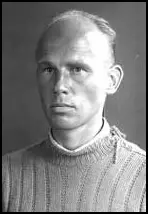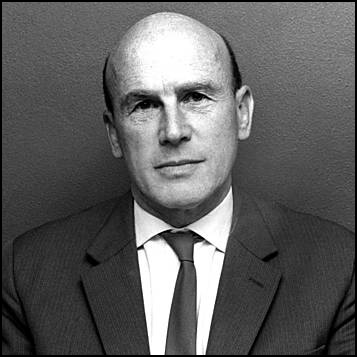Hermann Langbein

Hermann Langbein was born in Austria on 18th May 1912. After leaving college he worked as an actor at the Deutsches Volkstheater until 1933. That year he joined the Communist Party of Austria (KPÖ), which was banned the following year.
When Adolf Hitler announced the union (Anschluss) of Austria and Germany he fled to France. In April 1938 he joined the International Brigades and fought against the Nationalist Army in the Spanish Civil War. After the victory of General Francisco Franco Langbein fled to France. However, he was interned and after the invasion of the country by the German Army in May 1940, he was sent to Nazi Germany.
Langbein arrived in Dachau on 1st May 1941. He later wrote in Against All Hope (1992): "On May 1, 1941, I arrived in Dachau together with many other Austrian veterans of the Spanish Civil War. For over two years, we had been interned in camps in southern France, and only internees who live together day and night can get to know one another as well as we did... The general expressions of support from the old political prisoners that greeted us, the first large group of veterans of the Spanish Civil War to arrive in Dachau, did us good morally and in some instances helped us concretely as well."
Langbein was shocked by conditions in the camp. "We had to march out at dawn onto the parade ground for early morning roll call. It was always a dreadful military ceremony. Everyone had to stand bolt upright in rows. The order hats off had to be done with total precision. If there was some mistake or other, then there were punishment exercises. Then the SS took the roll call - to check whether the numbers tallied. That was always the most important thing in every concentration camp - the numbers had to be right at every roll call. No one was allowed to be absent. It made no difference if someone had died during the night - the body would be laid out and included in the roll. And then, when roll call was over, we had to form up into our working parties. And every working party had its own assembly area, which one had to know in order to line up. And then the parties set off for work - depending on whether one was working inside the camp or outside. The outside parties were escorted by SS men. The working day was determined by the time of year. Work was determined by hours of daylight, not the clock. The parties could only leave camp when it was already half-light, so that people couldn't escape under cover of darkness."
Langbein was able to survive the experience by gaining a job in the camp hospital: "A German Communist who had been interned for many years - presented me to his SS boss, who had a request for a clerk from the prison hospital... The Work Assignments man told him that no other inmates were available who had the proper qualifications - the ability to spell correctly, use a typewriter, and take shorthand. He had prepared me in advance to answer the SS questions in such a way that I made a positive impression. With surprising speed, I was placed on a detail with exceptionally good working conditions. Because we also slept in the infirmary, we were not subject to the harassing checks in the blocks. We did not need to show up for the morning and evening roll calls, and we had a roof over our heads as we did our physically undemanding work."
In August 1942 Langbein was sent to Auschwitz to help combat an outbreak of typhus. He became a clerk and spent his time typing out death notices. Later he became clerk to the chief medical officer at Auschwitz, Dr Eduard Wirtz. Andrew Mollo, the author of To The Death's Head: The Story of the SS (1982): "Langbein reminded us that the camp doctors were the only academics on the camp staff, and while some of them, like Doctors Mengele and Entress, were anti-Semites and worked willingly in the murder system, there were others like Wirtz who tried whenever possible to alleviate the suffering around them. By the judicious use of his Viennese charm and by insisting on addressing Wirtz as 'Herr Doktor' instead of using his SS rank, Langbein feels he was able to exert a tiny but very important civilizing influence on him."

Langbein managed to escape from an evacuation transport in April 1945. In Hanover, he wrote his first account of Auschwitz, which he gave to the Allied forces. In 1947 he began to write a book, The Stronger Ones: A Report from Auschwitz and Other Concentration Camps, which was published by the Communist Party’s publishing house in 1949. In 1951 he came into conflict with the Communist Party of Austria leadership, was not reelected to the Central Committee, and was “transferred for disciplinary reasons,” along with his wife, Loisi, and his little daughter, to Budapest in 1953. There he worked for German-language programs of the Hungarian radio broadcasting service.
In 1954, he joined other former prisoners in founding the International Auschwitz Committee (IAC) and became its general secretary. He fought for compensation payments from industrial firms, including I.G. Farben, that had profited from the forced labor of Auschwitz prisoners; he was involved, with some success, in the legal prosecution of SS members in West Germany and Austria; and he sought to bring the crimes of the National Socialists, particularly in Auschwitz, into the public eye.
In 1958, after his public protest against the execution of Imre Nagy, the former prime minister of Hungary, he was expelled from the party. As the IAC was under the control of the Communist Party of Austria, he was now seen as an "enemy" and in 1960, he lost his position as general secretary, and then, in 1961, he was excluded from the management.
In 1962, Hermann Langbein, along with H. G. Adler and Ella Lingens, published the anthology Auschwitz: Testimonies and Reports, and the following year saw the appearance of his book In the Name of the German People: Interim Balance Sheet for the Trials of National Socialist Crimes. In 1965, his two-volume documentation, The Auschwitz Trial, was published. This was followed by English as People in Auschwitz (1972) and Against All Hope (1992).
Hermann Langbein died in Vienna on 24th October 1995.
Primary Sources
(1) Andrew Mollo, To The Death's Head: The Story of the SS (1982)
In August 1942 Langbein joined a group of German inmates which was sent to Auschwitz to help combat an outbreak of typhus which had struck without discriminating between the SS and the inmates. Langbein became a clerk and spent day and night typing out death notices. Later he became clerk to the chief medical officer at Auschwitz, Dr Eduard Wirtz. Langbein reminded us that the camp doctors were the only academics on the camp staff, and while some of them, like Doctors Mengele and Entress, were anti-Semites and worked willingly in the murder system, there were others like Wirtz who tried whenever possible to alleviate the suffering around them. By the judicious use of his Viennese charm and by insisting on addressing Wirtz as 'Herr Doktor' instead of using his SS rank, Langbein feels he was able to exert a tiny but very important civilizing influence on him.
While Langbein is bitterly against any tendency which romanticizes or glorifies the achievements of the Waffen-SS, and considers that the Waffen-SS claim to have had nothing to do with the concentration camps as a downright lie, he is equally adamant that one can only judge a former SS man on the basis of his personal conduct.
(2) Hermann Langbein, Against All Hope (1992)
We had to march out at dawn onto the parade ground for early morning roll call. It was always a dreadful military ceremony. Everyone had to stand bolt upright in rows. The order "hats off" had to be done with total precision. If there was some mistake or other, then there were punishment exercises. Then the S S took the roll call - to check whether the numbers tallied. That was always the most important thing in every concentration camp - the numbers had to be right at every roll call. No one was allowed to be absent. It made no difference if someone had died during the night - the body would be laid out and included in the roll. And then, when roll call was over, we had to form up into our working parties. And every working party had its own assembly area, which one had to know in order to line up. And then the parties set off for work - depending on whether one was working inside the camp or outside. The outside parties were escorted by SS men. The working day was determined by the time of year. Work was determined by hours of daylight, not the clock. The parties could only leave camp when it was already half-light, so that people couldn't escape under cover of darkness. Work lasted 'till noon. At midday we formed up and ate lunch. There were some working parties who had their food outside the camp. It was a kind of soup, that had a few bits and pieces floating about; it was difficult to identify what exactly. And then we carried on working until the evening roll call. In the evening, the working parties formed up again on the parade ground. The same military ceremony, which is described here much faster than the time it actually took. We were counted up again, and if the figures were correct, if the
- roll call was in order, we were allowed to march off into the blocks - to our own living quarters - and we had to sing as we went; and woe betide anyone who didn't sing.
(3) Hermann Langbein, People of Auschwitz (2004)
Living conditions in the concentration camps changed materially in the course of the years, and so did the conditions for resistance activity. Such activities were, of course, also decisively influenced by developments at the front. There is no need to discuss the course of the war here. The changes in the camps will be discussed to the extent that they were significant for resistance activity, but first I must briefly cover the period from 1933 to 1938.
Unlike some institutions in other countries that gave the Nazi concentration camps their name, the latter were not a concomitant of the war. From the outset they constituted a major component of the terrorism on which National Socialism was based. In other areas Nazism continued certain traditions, but in the special field of terrorism, it was inventive and struck out in new directions.
At an early stage, various internment camps for political opponents - spontaneously established after Hitler's appointment as Reich chancellor-were placed under the central administration of the SS. This laid the foundation for the SS state. The first concentration camp was Dachau, and the central administration always regarded it as a model camp whose institutions were copied by the other camps. At the beginning of the period under discussion here, before April 2, 1938, Buchenwald and Sachsenhausen were in operation as well.
